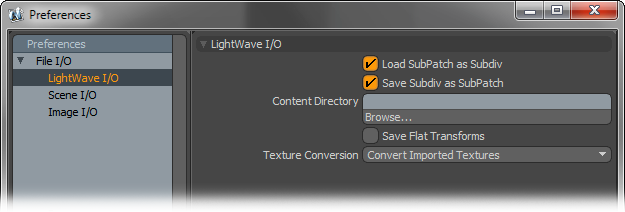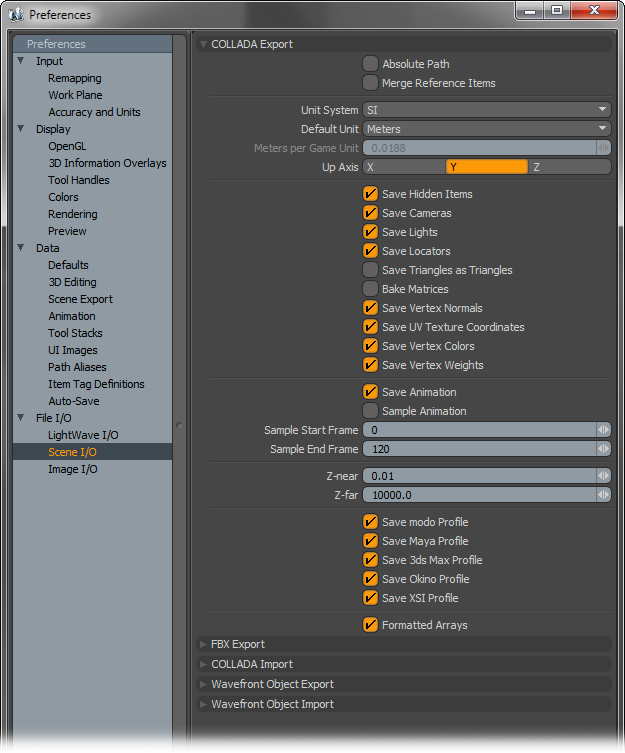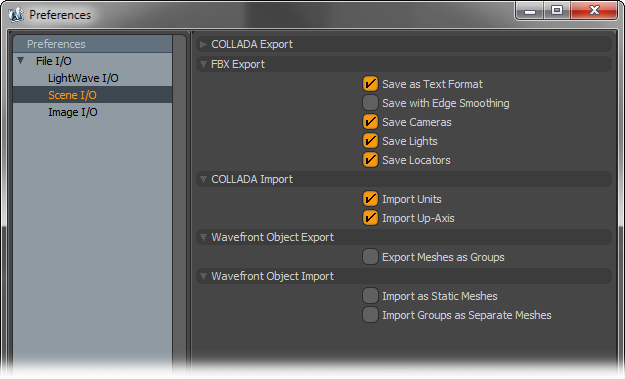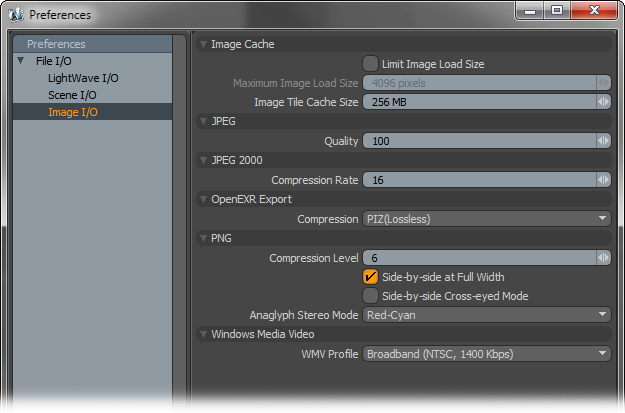Accessible from the menu bar under "System > Preferences...", the modo preferences define the default behavior for a variety of options and functions in modo, further customizing the application to suit users particular tastes and needs. The Preferences are categorized into four main functions- 'Input' deals with ways users interact with the application, 'Display' controls the various way viewports display geometry and information. The 'Data' section controls default behaviors for data created in modo and finally 'File I/O' controls how scenes are imported and exported when dealing with external applications.

LightWave I/O--
Load SubPatch as Subdiv: When this option is enabled, any geometry generated in LightWave using 'SubPatch' geometry smoothing technique will automatically convert to modo's standard Subdiv when imported.
Save Subdiv as SubPatch: Conversely, any geometry modeling modo as a Subdivision Surface can be converted to LightWave's Subpatch mode upon export to LightWave format.
Content Directory: LightWave supports a content directory structure to ease in moving scene files around. When loading scene dependant on Content Directories, it is helpful to specify the LightWave equivalent path prior to loading and saving the file to aide modo in locating the appropriate assets (namely image maps) into and out of modo.
Save Flat Transforms: Saving full modo scenes to LWO object files means saving out all the meshes to mesh layers. Typically the item transformations applied in modo are not applied to the mesh, so it will be positioned as if the item mode rotation, scale and positioning were all reset. Turning this option on freezes all the layers of item transformation, so the entire hierarchy will be exported as if modeled in that pose.  Sometimes this behavior is undesirable if users will be rigging the layers later.
Texture Conversion: This option attempts to reproduce the LW texturing in the Shader Tree. Use this if exporting textures unchanged back to LWO is not important.

COLLADA Export--
For user convenience, the 'Absolute Path', 'Merge Reference Items', 'Unit System', and 'Up Axis' settings are included in both their original locations on the 'Accuracy and Units', and 'Scene Export' panels, as well as in the COLLADA Export panel. Changing any of these settings in the COLLADA Export panel will also change the value globally, such that the new setting value updates in the original preference group panels as well.
Save Hidden Items: Saves items that are hidden in the Items tree.
Save Triangles as Triangles: Saves mesh items that are constructed of triangles using the COLLADA <triangles> element, instead of the more general-purpose <polylist> element.
Bake Matrices: The COLLADA format can represent modo's stack (or layers) of multiple transform elements, such that more than one rotation, position, or scale can be applied to a single item in series. For compatibility with other applications, Bake Matrices will reduce such a transform stack down to a single transform by pre-multiplying the results before export.
Save Vertex Normals: Enables the saving of normals for each geometry vertex.
Save UV Texture Coordinates: Enables the saving of one or more UV texture coordinate maps for each mesh item.
Save Animation: This option enables or disables the output of animation channels. When Save Animation is disabled, all item values are sampled at the first frame of any animated channels.
Sample Animation/Sample Start Frame and Sample End Frame: Creates a keyframe value at every frame within the range specified by the Start and End Frame settings. This option is useful when exporting to applications that do not know how to interpolate all of the animation channels in a given file.
Z-near and Z-far: The Z-buffers on 3D graphics cards have limited resolution, and so these settings describe the closest and furthest points that may be displayed for a given scene. Z-near and Z-far are not applicable for the types of rendering performed by modo, but can be useful for interactive 3D applications where this information can be used to optimize the resolution of the hardware Z buffer.
Save modo Profile: This option provides a human-readable form of virtually all of modo's items and their internal channels and animation envelopes, and also allows the modo COLLADA importer to re-import assets with the same modo-specific items and their channels and envelopes. A full description of the modo profile is beyond the scope of this document, so please refer to the colladaI/O documentation included with the File I/O SDK for additional details (available in modo's help directory as part of the SDK).
Save Maya Profile: The following Maya profile elements are output by the modo COLLADA exporter:
pre_infinity
post_infinity
These elements describe the animation curve prior to the first keyframe, and after the last keyframe, respectively, of a given channel. This feature is very powerful when many other tracks are animated on a larger time window, and the animator wants to quickly animate yet another parameter without having to manually place and adjust the values of the keyframes to match the outermost keyframes of the overall animation, for which the overall animation time window may be delimited on a track that is far away on the channel stack.
Save 3ds Max Profile: The following 3ds Max profile element is output by the modo COLLADA exporter:
frame_rate -- Specifies the frames per second at which animation is evaluated and rendered.
Formatted Arrays: This option breaks up long lists of values into related groups on separate lines, which makes the output text easier to read.

FBX Export--
Save as Text Format: When this option is enabled, modo will generate human-readable TXT formatted FBX files. However, keep in mind TXT readable files can be many times the size of binary encoded FBX files, the format generated when this option is disabled.
Save with Edge Smoothing:
Save Cameras: When this option is enabled, modo will export all camera items to the FBX format.
Save Lights: When this option is enabled, modo will export all light items to the FBX format.
Save Locators: When this option is enabled, modo will export all locator items to the FBX format.
COLLADA Import--
Import Units: This option, when enabled will read and apply the 'Unit's' information from a COLLADA file to the imported modo scene.
Import Up Axis: This option, when enabled will read and apply the 'Up Axis' information from a COLLADA file to the imported modo scene.
Wavefront Object Export--
Export Meshes as Groups: Determines whether the export utilizes the 'G' group tag or 'O' object tag when defining geometry sections within the file.
Wavefront Object Import--
Import as Static Meshes: This option, when enabled, will import OBJ format geometry as a Static Mesh.
Import Groups as Separate Meshes: When this option is enabled, modo will create a separate Mesh Item layer each time it encounters a 'G' group tag.

Image I/O--
Limit Image Load Size: When this option is enabled, modo will limit the size of large bitmap images when imported an rendered, based on the setting of the Maximum Image Load Size. As large images are loaded they will be resized so they take about the same memory as a square image with the given dimensions. This can be useful if you're editing a model that's been textured with very large maps and don't need to see them in detail. The preference should be used with caution, however, as it will affect rendering.
Maximum Image Load Size: Determines the maximum pixel length for any image imported. Images larger than this setting will be resized.
Image Tile Cache Size: Amount of space dedicated to holding resized images in memory. The more images loaded and resized, the more memory will be necessary to hold them all.
JPEG--
Quality: This option determines the image/compression quality of images saved from modo into the JPEG format (jpg file extension). 100% is maximum quality possible with JPEG, lower values will reduce the file's overall size, but also degrades image quality.
JPEG 2000--
Compression Rate: This option determines the image/compression quality of images saved from modo into the JPEG 2000 format (jp2 file extension). 100 is maximum compression possible, Low values will increase the file's overall size, increasing the value toward 100 will decrease the file size but also degrade image quality.
OpenEXR Export--
Compression: When saving OpenEXR images users are provided with a number of different compression offerings, from uncompressed, to Lossless, to lossy compression types. It is best to test setting for the intended purpose to make sure the format chose is compatible with the intended target.
Compression Level: PNG format uses a lossless compression scheme similar to ZIP. Value span from 1 to 9, with 9 being the greatest amount of compression. Compression amount won't affect the visual quality of the images, but will affect compression and decompression performance, which can be useful when playing back image sequences.
Side-by-side as Full Width: With this option enabled, when saving Stereo PNG images, saved images will be twice as wide as the specified frame width, preserving the full rendered resolution for each stereo pair. When disabled, images will be scaled to half width upon saving retaining the original frame width value.
Side-by-side Cross-eyed Mode: Reverses the left/right images, placing them in the opposite position of the image.
Anaglyph Stereo Mode: modo provides several options for saving out stereo anaglyph images--
Red-Cyan- This method replaces the red channel or the right image with the red channel from the left image.
Grayscale- This method makes both frames into grayscale (luminance) images, then puts the left one in the Red output channel and the right one in the Green and Blue channels.
Red-Cyan Half Color- This method converts the left image to grayscale and puts it into the Red channel, and uses the right frame's Green and Blue channels for the output Green and Blue channels. This technique reduces 'retinal rivalry' which is a disturbing phenomenon caused by differing brightness of what should be the same objects seen by either eye.
Red-Cyan 'Optimized'- This method further combats retinal rivalry by discarding the red channel from both images, keeping the right frame's cyan component, and mixing the left frame's Green and Blue channels at 70%/30% ratio to use in the output red channel.
Windows Media Video--
Windows Media Video: Users can use these setting to determine the compression template settings for saving movies and rendering viewport previews.


